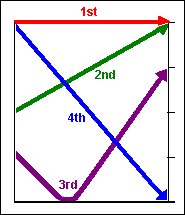Mandarin Chinese has four pitched tones and a "toneless" tone. The reason for having these tones is probably that the Chinese language has very few possible syllables -- approximately 400 -- while English has about 12,000. For this reason, there may be more homophonic words , words with the same sound expressing different meanings, in Chinese than in most other languages. Apparently tones help the relatively small number of syllables to multiply and thereby alleviate but not completely solve the problem. Learning Chinese in context, therefore, is very important.
Can you imagine that the Chinese use only three syllables when expressing the same meaning as each of the following sentences conveys? (Click on each of the sentences to see the corresponding Pinyin with their tones marked. Then click on the speaker icon to listen.)
Now you can understand how
the Chinese use only one syllable "da" and yet can tell the difference
betwee "to hang over something" (![]() da1 ), "to answer" (
da1 ), "to answer" (![]() da2),
"to hit" (
da2),
"to hit" (![]() da3),
and "big" (
da3),
and "big" (![]() da4).
Yes, the secret lies in the tones.
da4).
Yes, the secret lies in the tones.
The numbers after each of
the syllables indicates the tone. In normal text this is indicated as ![]() .
In the diagram below you can see the tones.
.
In the diagram below you can see the tones.
|
This diagram helps visualize the pitches of the four tones:

The tone of a syllable may
change in some situations. For example, these are the characters for "mother"
![]() .
As separate characters each is pronounced as "ma," but when put together,
the second "ma" becomes toneless:
.
As separate characters each is pronounced as "ma," but when put together,
the second "ma" becomes toneless: ![]() .
Rules like this are, however, very few and very easy to remember.
.
Rules like this are, however, very few and very easy to remember.